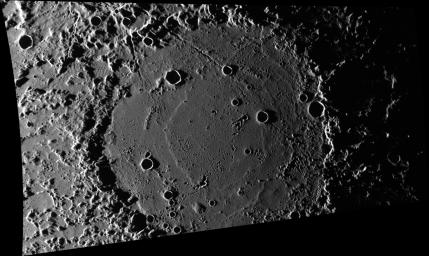
|
Van Eyck and the Formation
- Click the image above for a larger view
- Full-Res JPEG (2263 x 1352) (414.3 kB)
- Full-Res TIFF (2263 x 1352) (3.1 MB)
Caption:
The low Sun elevation in this scene emphasizes the topography of Van Eyck crater. The rim of Van Eyck has been profoundly cratered by material ejected from the Caloris basin. Smooth plains fill the floor of Van Eyck, but they too have been affected by cratering, from large primary impacts to deep, linear incisions by secondary crater chains.
Jan Van Eyck was a Flemish painter who lived from about 1390 to 1441 CE. The stratigraphic unit comprising the ejecta from the Caloris basin is named the Van Eyck Formation. The Van Eyck Formation is regarded by scientists as equivalent to the Fra Mauro Formation that surrounds the Moon's Imbrium basin. The Van Eyck Formation is characterized by elongated hilly ridges and grooves that are sub-radial to the Caloris Basin, and which are extensively embayed by smooth plains.
This image was acquired as part of MDIS's high-incidence-angle base map. The high-incidence-angle base map complements the surface morphology base map of MESSENGER's primary mission that was acquired under generally more moderate incidence angles. High incidence angles, achieved when the Sun is near the horizon, result in long shadows that accentuate the small-scale topography of geologic features. The high-incidence-angle base map was acquired with an average resolution of 200 meters/pixel.
Date acquired:
June 21, 2013
Image Mission Elapsed Time (MET):
14100380
Image ID:
4296279
Instrument:
Wide Angle Camera (WAC) of the Mercury Dual Imaging System (MDIS)
WAC filter:
7 (748 nanometers)
Center Latitude:
43.78°
Center Longitude:
202.5° E
Resolution:
239 meters/pixel
Scale:
Van Eyck crater is about 270 km (168 mi.) in diameter
Incidence Angle:
86.7°
Emission Angle:
55.3°
Phase Angle:
142.0°
North is up in this image.
Background Info:
The MESSENGER spacecraft is the first ever to orbit the planet Mercury, and the spacecraft's seven scientific instruments and radio science investigation are unraveling the history and evolution of the Solar System's innermost planet. During the first two years of orbital operations, MESSENGER acquired over 150,000 images and extensive other data sets. MESSENGER is capable of continuing orbital operations until early 2015.
For information regarding the use of images, see the MESSENGER image use policy .
Cataloging Keywords:
| Name | Value | Additional Values |
|---|---|---|
| Target | Mercury | |
| System | ||
| Target Type | Planet | |
| Mission | MESSENGER | |
| Instrument Host | MESSENGER | |
| Host Type | Orbiter | |
| Instrument | Mercury Dual Imaging System (MDIS) | |
| Detector | Wide Angle Camera (WAC) | |
| Extra Keywords | Crater, Grayscale, Impact, Map, Moon, Radio, Shadow | |
| Acquisition Date | ||
| Release Date | 2014-11-14 | |
| Date in Caption | 2013-06-21 | |
| Image Credit | NASA/Johns Hopkins University Applied Physics Laboratory/Carnegie Institution of Washington | |
| Source | photojournal.jpl.nasa.gov/catalog/PIA18950 | |
| Identifier | PIA18950 | |
